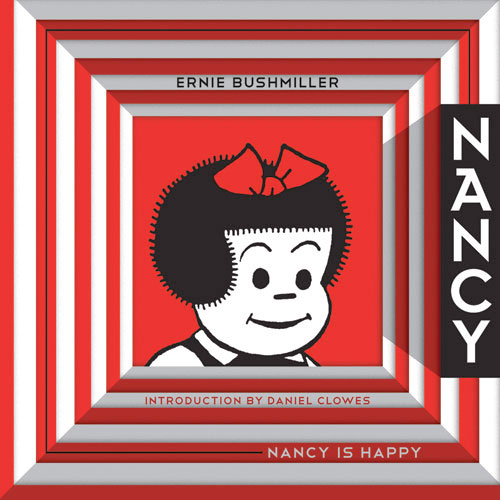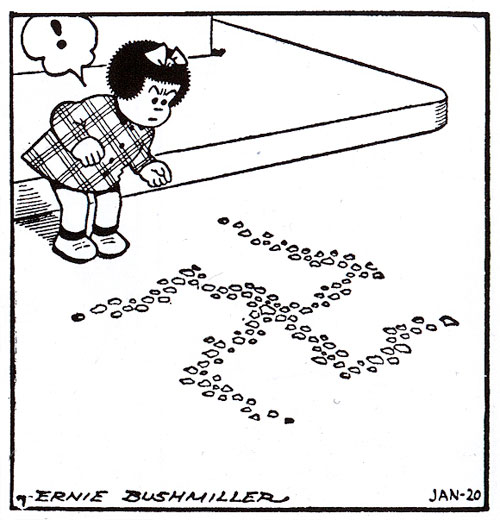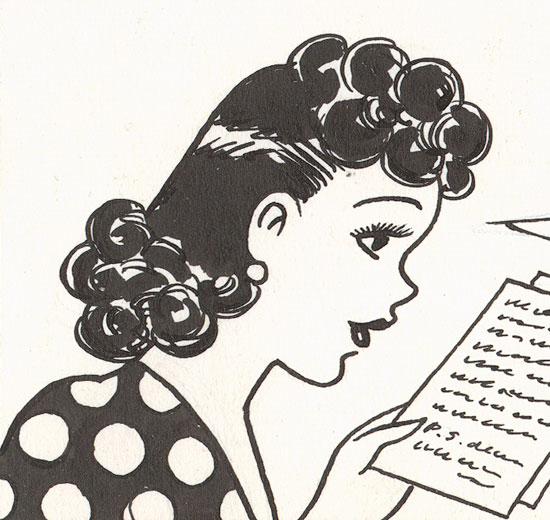
Fantagraphics has answered the prayers of all of us pedantic, irritating Bushmiller junkies with the exciting release of their debut volume of systematic reprints of Nancy, containing a whopping three years of dailies from the early 40s. They've promised to continue the series through the 1950s, but after that, their plans are vague, so it's very important that you purchase these books!
This first example is beyond thrilling.
Bushmiller's strips can be divided roughly into four periods: the theme-based gags of the 20s. the continuing storylines of the 30s, a return to theme-based gags in the 40s, and finally the gloriously random gag-a-day strips of the 50s and thereafter. This volume follows the "themed gag" approach surprisingly faithfully: Bushmiller picks a topic (Nancy gets a pet monkey, Nancy and Sluggo open a club for soldiers, Sluggo takes up fortune-telling, Nancy gets a pet pig), and then does 1-3 weeks of gags based on the topic. There are only occasionally stand-alone strips which don't hew to a theme.
It's a good way to approach the job, but a bit of a crutch, too. Eventually Bushmiller didn't need that crutch, and abandoned the use of themes.
What's really interesting about the 40s strips is how often Bushmiller refers to happenings in the news, particularly the war. He never completely ignored current events (in the 50s he made Cold War jokes, in the early 60s he made Kennedy jokes, in the late 60s he made hippie jokes, etc.) but really engages with the "real world" in these early 40s strips, with more or less constant references to soldiers, rationing, the wickedness of Japan, and even, jarringly, Hitler.

I've already spoken here about the differences in the artwork in Bushmiller's earlier work when compared to the crystalline minimalism of his later work, and it's again surprising to see just how detailed and packed with clutter his panels are here. It's almost like he's plagued by horror vaccui, and is afraid to allow large white spaces to stand on their own, as he would brilliantly later. Instead, there's an incredible amount and variety of different hatching and shading techniques, fussy and obsessive, which are as fastidiously executed as his increasingly standardized characters.

(detail of original drawing from 1944)
Otherwise, the joke structure of these earlier strips is pretty much the same as Bushmiller's later efforts. He really knows how to set 'em up and knock 'em down.
But I've already gone on too long. Obviously you need to buy this book. And you can see from my own collection one of the original drawings for a strip reprinted in this volume here (detail above) And this one, presumably, will be represented in Volume 2: 1946-1948. Can't wait!
My only reservation about this series so far is the design. The cover and endpapers baffled me, and then the white type on black and red backgrounds for Dan Clowes' and the editors' somewhat meager introductions annoyed me. I don't mind at all that the Sunday strips aren't included; they're a different animal.
Disclaimer: I did some freelance writing for Fantagraphics in the 90s when they briefly published Your Flesh magazine. And, obviously, I'm a crazily obsessive Nancy fan whose objectivity can be safely doubted.
Only you can decide to accept Ernie Bushmiller as your personal savior.
5 comments:
We are continually fascinated by the response of popular culture to the war effort, and can't help but believe that there's a brilliant book/treatise/term paper that compares WWII domestic propaganda, which in our humble opinion was brilliant and two-edged, with post-9/11 pablum, which was, um not. Just our two cents.
Brilliant stuff on your part, PSP.
On my part? I didn't have anything to do with it.
Suppose there were a Nancy original drawing tracking service that knew where all the original Nancy drawings were at any given time. Then, when projects like this occurred, some guy from Fantagraphics would arrange to show up at your door to scan your originals. That way the collection is up to date with the current state of the originals.
Thatte's so cool how the plaid pattern on her jacket just continues unimpeded onto and across her right arm and left wrist. Itte's a clever wry visual joke.
Post a Comment